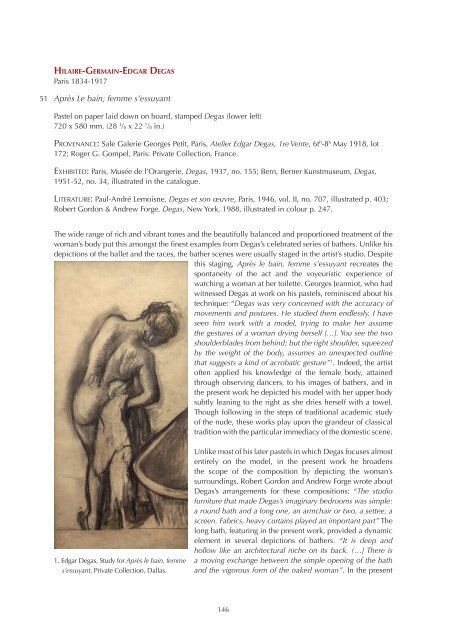Catalogue-2014-Jean-Luc-Baroni
- No tags were found...
Create successful ePaper yourself
Turn your PDF publications into a flip-book with our unique Google optimized e-Paper software.
Hilaire-Germain-Edgar Degas<br />
Paris 1834-1917<br />
51<br />
Après Le bain, femme s’essuyant<br />
Pastel on paper laid down on board, stamped Degas (lower left)<br />
720 x 580 mm. (28 3 /8 x 22 7 /8 in.)<br />
Provenance: Sale Galerie Georges Petit, Paris, Atelier Edgar Degas, 1re Vente, 6t h -8 h May 1918, lot<br />
172; Roger G. Gompel, Paris: Private Collection, France.<br />
Exhibited: Paris, Musée de l’Orangerie, Degas, 1937, no. 155; Bern, Berner Kunstmuseum, Degas,<br />
1951-52, no. 34, illustrated in the catalogue.<br />
Literature: Paul-André Lemoisne, Degas et son œuvre, Paris, 1946, vol. II, no. 707, illustrated p. 403;<br />
Robert Gordon & Andrew Forge, Degas, New York, 1988, illustrated in colour p. 247.<br />
The wide range of rich and vibrant tones and the beautifully balanced and proportioned treatment of the<br />
woman’s body put this amongst the finest examples from Degas’s celebrated series of bathers. Unlike his<br />
depictions of the ballet and the races, the bather scenes were usually staged in the artist’s studio. Despite<br />
this staging, Après le bain, femme s’essuyant recreates the<br />
spontaneity of the act and the voyeuristic experience of<br />
watching a woman at her toilette. Georges <strong>Jean</strong>niot, who had<br />
witnessed Degas at work on his pastels, reminisced about his<br />
technique: “Degas was very concerned with the accuracy of<br />
movements and postures. He studied them endlessly. I have<br />
seen him work with a model, trying to make her assume<br />
the gestures of a woman drying herself […]. You see the two<br />
shoulderblades from behind; but the right shoulder, squeezed<br />
by the weight of the body, assumes an unexpected outline<br />
that suggests a kind of acrobatic gesture” 1 . Indeed, the artist<br />
often applied his knowledge of the female body, attained<br />
through observing dancers, to his images of bathers, and in<br />
the present work he depicted his model with her upper body<br />
subtly leaning to the right as she dries herself with a towel.<br />
Though following in the steps of traditional academic study<br />
of the nude, these works play upon the grandeur of classical<br />
tradition with the particular immediacy of the domestic scene.<br />
1. Edgar Degas, Study for Après le bain, femme<br />
s’essuyant, Private Collection, Dallas.<br />
Unlike most of his later pastels in which Degas focuses almost<br />
entirely on the model, in the present work he broadens<br />
the scope of the composition by depicting the woman’s<br />
surroundings. Robert Gordon and Andrew Forge wrote about<br />
Degas’s arrangements for these compositions: “The studio<br />
furniture that made Degas’s imaginary bedrooms was simple:<br />
a round bath and a long one, an armchair or two, a settee, a<br />
screen. Fabrics, heavy curtains played an important part” The<br />
long bath, featuring in the present work, provided a dynamic<br />
element in several depictions of bathers. “It is deep and<br />
hollow like an architectural niche on its back. (…] There is<br />
a moving exchange between the simple opening of the bath<br />
and the vigorous form of the naked woman”. In the present<br />
146
















